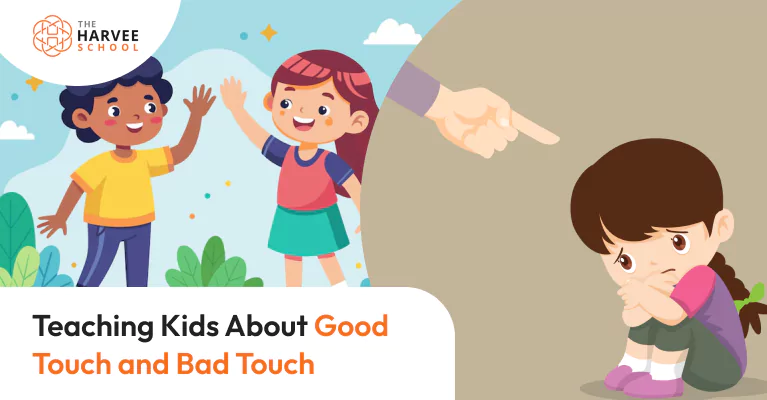Teaching Kids About Good Touch and Bad Touch
One of our primary responsibilities as parents is ensuring the safety and well-being of our children. The most important yet challenging conversations we need to have with them revolve around understanding the difference between good touch and bad touch. Teaching children about personal boundaries is crucial in empowering them to recognize inappropriate behavior and seek help when needed.
In this blog, we’ll explore how you, as a parent—especially moms who tend to have an intimate nurturing role—can approach this sensitive topic with confidence and care. From understanding the significance of body autonomy to practical tips on how to initiate the conversation, we’ll guide you through this important journey.
Why Teach Children About Good and Bad Touch?
Children, especially at younger ages, are naturally trusting and may not fully comprehend the concept of personal boundaries. While we might wish to protect them from the harsh realities of the world, educating them early about their bodies and personal space equips them with the ideas to navigate potentially unsafe situations.
Here are some reasons why this conversation is crucial:
Prevention of Abuse: Teaching kids what’s acceptable and what’s not can make them less likely to fall victim to inappropriate or abusive behavior.
Empowerment: When children know they have control over their own bodies, they feel empowered to speak up when something doesn’t feel right.
Building Trust: Open communication about complex topics creates a sense of trust between you and your child. This makes it easier for them to come to you if they ever feel uncomfortable.
What Is Good Touch vs Bad Touch?
Good touch is any physical interaction that feels safe, loving, and appropriate.
Examples of good touch can be:
- Hugs and kisses from parents or family members that are welcomed and reciprocated.
- A doctor’s exam with consent and explanation.
- Holding hands with friends, family, or caregivers when they feel comfortable.
Bad touch, on the other hand, is any touch that makes a child feel uncomfortable, scared, or confused.
- Unwanted or inappropriate touching by an adult or another child.
- Physical interactions that feel secretive or make them uneasy.
- Any contact with their private parts outside of necessary medical context.
How to Teach Good Touch and Bad Touch?
- Talk to them using age-appropriate language that they can easily understand.
- Explain that their body is their own, and they have the right to say no to any touch that makes them uncomfortable.
- Teach them that others should not touch private parts except for specific reasons like hygiene or medical exams, and only with a trusted adult present.
- Encourage them to trust their instincts. If any touch feels wrong, uneasy, or confusing, they should immediately tell a trusted adult or parents.
- Role-play different situations where they might need to say “no” firmly to someone. This practice helps them feel confident in asserting boundaries.
- Reinforce that they should never keep secrets about touch, even if someone tells them to. Always ensure they know they can talk to you about anything.
Tips to Discuss Sensitive Topics with Kids
While it’s essential to teach them about these things, it’s equally important to do so in a way that doesn’t scare or overwhelm your child. Approach the topic with care.
Teaching your child about boundaries and touch shouldn’t be a one-time conversation. It’s an ongoing dialogue that you’ll want to revisit periodically as your child grows older.
Select a time when they’re relaxed, perhaps during playtime or before bed. Keep the tone light but serious, ensuring they don’t feel anxious.
It’s natural for a child to feel a little scared when learning about bad touch. Reassure them that they are safe and that if something uncomfortable ever happens, they can always come to you for help.
Signs Your Child May Have Experienced Bad Touch
Even with open communication, some children may struggle to come forward after experiencing bad touch. As a parent, it’s essential to be alert to changes in your child’s behavior that could indicate something is wrong. Some signs might include:
- Sudden withdrawal or isolation
- Unexplained anger or irritability
- Regression to earlier behaviors, such as bedwetting or thumb-sucking
- Fear of specific people or places
- Difficulty sleeping or nightmares
If you notice any of these signs, gently approach your child and ask if they feel safe. Let them know they’re in a secure environment and that you’re there to support them no matter what.
What to Do If Your Child Tells You About a Bad Touch?
If your child discloses an incident of bad touch, it’s crucial to remain calm. Your immediate reaction will set the tone for how your child feels about the situation. Let your child speak without interrupting or dismissing their feelings.
Assure them that they did the right thing by telling you and that it’s not their fault. Depending on the situation, this might involve contacting authorities, speaking with school staff, or seeking professional help.
Conclusion
Teaching your child about good touch and bad touch is a crucial part of parenting. While it can feel like an uncomfortable topic to navigate, open communication is the key to empowering your child and protecting them from harm. By creating a safe, trusting environment, you’re giving your child the tools they need to recognize and report inappropriate behavior, helping them feel secure and confident as they grow.
Remember, these conversations are not about creating fear but about educating your child to understand their body, their boundaries, and their rights.






